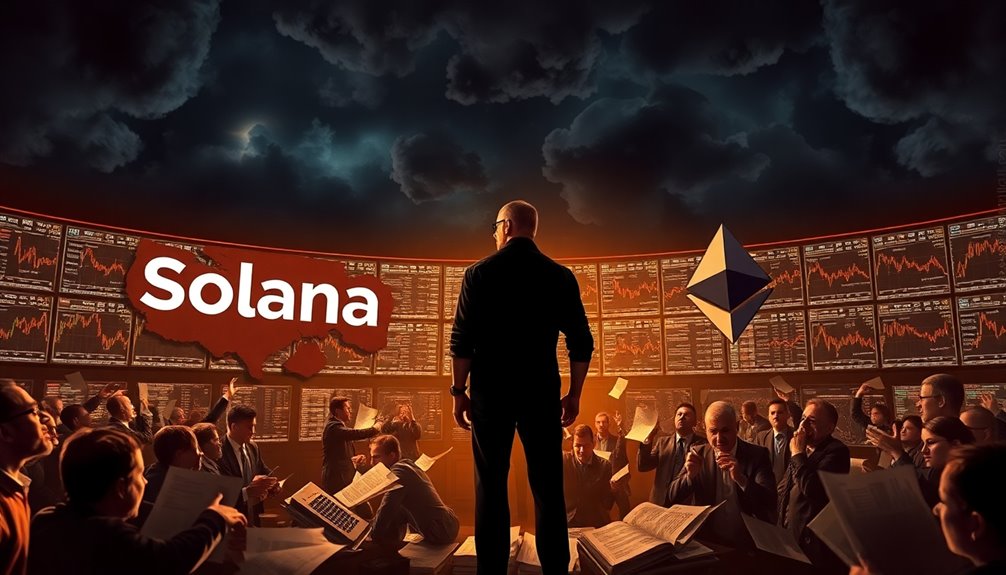Justin Drake's warning about Solana should definitely grab your attention. He believes the platform's rapid success might soon crumble under its architectural limits. While Solana currently handles over 65,000 transactions per second, these advantages could fade due to unsustainable growth and centralization risks. As Ethereum's Layer 2 solutions improve, they'll likely outpace Solana's capabilities, raising concerns for investors. If you're looking to stay informed and potentially protect yourself from the fallout, digging deeper into this evolving narrative might just reveal what's next for you in this dynamic landscape.
Key Takeaways
- Justin Drake warns that Solana's growth is unsustainable due to architectural limitations, signaling a potential decline in its performance.
- Solana's reliance on a single-server strategy raises concerns about centralization and vulnerability to exploitation.
- Network congestion and high transaction failure rates indicate that Solana may struggle to maintain its advertised capabilities under full load.
- Ethereum's Layer 2 solutions are anticipated to surpass Solana in terms of latency and throughput, attracting more developers and institutional interest.
- Investors should stay informed about market trends and volatility, considering risk management strategies to mitigate potential losses from Solana's challenges.
Justin Drake's Predictions

In recent discussions, Justin Drake has issued a stark warning about Solana's future, predicting that its golden age is nearing an end. He argues that the rapid growth and influence Solana has enjoyed are unsustainable.
While its speed and throughput currently set it apart, these advantages won't last. The architectural limitations of Solana render it unscalable, and as Ethereum's Layer 2 solutions evolve, they're poised to outshine Solana in both latency and throughput. Furthermore, Layer 2 solutions are specifically designed to address transaction speed and cost issues, further enhancing Ethereum's competitive edge.
Drake emphasizes that Solana's single-server strategy constrains its performance. Validation nodes require large servers, but they've hit a ceiling, making it impossible for Solana to greatly increase its gas limit.
This lack of horizontal scaling will hamper its long-term viability. In contrast, Ethereum's Layer 2 architecture is designed for sustainable growth, focusing on transaction speed, cost efficiency, and security.
If you're invested in the blockchain landscape, it might be time to reconsider your position. Drake's predictions suggest that Solana's peak performance could signify the beginning of its decline, leaving you to wonder if you're prepared for the potential fallout.
Solana's Current Advantages

When you look at Solana's current advantages, you'll notice its impressive speed and throughput metrics stand out. The network's innovative technologies and development momentum keep it competitive in the blockchain landscape. As you explore these factors, you'll see why Solana remains a significant player despite ongoing challenges. Additionally, its ability to handle over 65,000 transactions per second suggests that Solana is well-equipped to support a growing ecosystem of decentralized applications.
Speed and Throughput Metrics
Solana's speed and throughput metrics set it apart in the blockchain landscape, boasting a theoretical transaction capacity of up to 710,000 transactions per second. This impressive capability, combined with its architectural advantages, allows it to excel in real-world scenarios, consistently handling between 5,000 and 10,000 transactions per second. On peak days, Solana has processed over 95 million transactions, underscoring its efficiency. Additionally, the blockchain is designed to double its capacity every two years, in alignment with Moore's Law.
Here's a comparison of Solana's performance against other blockchains:
| Blockchain | Transactions Per Second (TPS) |
|---|---|
| Solana | Up to 710,000 (theoretical) |
| Ethereum | 22.8 TPS |
| Bitcoin | 10.7 TPS |
| Ripple | 400 TPS |
| Visa | 40,000 TPS |
With Solana being around 10,000 times faster than Bitcoin and 4,000 times faster than Ethereum, it leads the charge in throughput. The unique Proof of History consensus mechanism and innovative block propagation techniques guarantee that Solana not only meets but exceeds the demands of today's decentralized applications. If speed matters to you, Solana's metrics are hard to overlook.
Development Momentum and Innovation
Harnessing cutting-edge technology, Solana has rapidly positioned itself as a leader in the blockchain space through its unique development momentum and innovative features.
Its hybrid consensus mechanism, combining Proof-of-Stake and Proof-of-History, enhances efficiency, making transactions faster and more reliable. You'll appreciate how Solana supports stateless smart contracts, which separate program logic from data storage, boosting security and logical isolation. Furthermore, the growing adoption of Proof-of-Stake protocols in the crypto space indicates a shift towards more sustainable and efficient systems.
As you explore the ecosystem, you'll find Solana's smart contracts automate on-chain activities, eliminating intermediaries and improving overall efficiency. With lower transaction fees compared to other networks, you can execute token swaps and automatic transfers seamlessly.
The platform's Command Line Interface and JSON RPC API facilitate easy interactions with decentralized applications.
Moreover, the Total Value Locked in Solana has surged almost 80% to $9.4 billion recently, signaling growing institutional interest and contributing to Solana's overall market performance.
With 194 protocols hosted on the platform, and popular memecoins boosting its brand among retail investors, Solana's ecosystem is thriving.
As you navigate this landscape, you'll see how ongoing technological improvements continue to solidify Solana's position as a powerhouse in blockchain development.
Current Competitive Landscape
In today's fast-paced blockchain environment, Solana stands out with its impressive scalability and transaction speed, giving it a distinct edge over competitors. With the ability to handle up to 65,000 transactions per second, Solana's high throughput is unmatched. Its multi-threaded approach allows for parallel transaction execution, ensuring that slot times hover around 500-600 milliseconds, greatly speeding up the process.
You'll appreciate how Solana's 'Proof of History' consensus mechanism boosts efficiency, allowing for quick confirmations and direct routing of transactions to validators. This reduces confirmation times, making it a go-to for developers and users alike. Additionally, Solana's low transaction costs make it an attractive option for projects with budget constraints.
Moreover, Solana's interoperability facilitates seamless integration with various blockchain technologies, enriching its ecosystem, which includes a robust marketplace for NFTs and a plethora of DeFi applications. Its low transaction costs—fixed at just 0.000005 SOL—ensure that users can engage with the network without worrying about exorbitant fees.
Despite its rapid growth, Solana maintains a high level of security and is climate-friendly due to its low computing power requirements. This combination of speed, scalability, and low costs positions Solana as a formidable player in the current competitive landscape.
The Latency and Throughput Battle

The battle between latency and throughput in blockchain technology has become a defining factor in the competition between Solana and Ethereum.
Solana boasts an impressive average latency of just 200-400 milliseconds, making it ideal for applications that require near-instant transaction settlements. Its use of Proof of History (PoH) enhances transaction processing efficiency, supporting high-frequency trading and gaming applications. This focus on high throughput allows Solana to maintain its competitive edge in various markets.
In contrast, Ethereum's longer block times lead to delayed transaction confirmations, though upcoming pre-confirmation mechanisms could reduce latency to around 10 milliseconds.
When it comes to throughput, Solana outshines Ethereum by processing over 2,600 transactions per second (TPS) through sharding and parallel processing. This high throughput is critical for applications demanding rapid transaction execution.
Ethereum, on the other hand, currently handles only 15-30 TPS on Layer 1, though Layer 2 solutions promise to greatly boost this figure—potentially increasing throughput by up to 10,000 times next year.
While Solana currently holds an edge in latency and throughput, Ethereum's strategic investments in Layer 2 technologies could soon shift the balance.
The ongoing competition will ultimately determine which platform can best serve the evolving needs of users.
Scalability Challenges for Solana

You might notice that Solana's architectural limitations are starting to show, especially when it comes to handling complex transactions. As the network grapples with increased demand and congestion, these issues could hinder its ability to scale effectively. If you're a user, you may feel the impact on your experience as transaction complexity continues to rise. Additionally, the introduction of Firedancer's ability to handle high transaction volumes aims to address these scalability challenges but raises questions about the network's overall resilience.
Architectural Limitations
Solana's architectural limitations pose significant challenges to its scalability, raising doubts about its long-term viability. As you explore Solana, you'll notice several critical issues that could impact your experience as a user:
- Centralization Risks: With a limited number of validators, Solana's network faces centralization concerns, making it vulnerable to exploitation and manipulation. This is similar to how refrigerant levels in heat pumps must be carefully managed to ensure efficient operation.
- Network Congestion: An influx of spam transactions and bot activities leads to congestion, causing transaction processing delays and high failure rates, estimated between 50% to 80%. Despite its claims, Solana's current performance is challenged by its 3.25 million daily active users. Regular maintenance, akin to what is necessary for heat pumps, can prevent many of these issues from escalating.
- Throughput Discrepancies: Despite claims of high throughput, actual transaction speeds fall short under full network conditions, leading to user dissatisfaction. Just as understanding the refrigeration cycle aids in troubleshooting heat pump efficiency, a deeper comprehension of Solana's architecture could help users navigate its limitations.
- Security Vulnerabilities: Solana has experienced network outages that disrupt services, raising concerns about reliability and potential financial losses for users. Similar to how professional servicing enhances the performance of heat pumps, expert oversight might improve the resilience of blockchain networks against outages.
These architectural challenges indicate that Solana may struggle to maintain its competitive edge in the evolving blockchain landscape.
As you consider your options, weigh these limitations against the promises of other platforms that might offer more robust scalability and security.
Transaction Complexity Impact
How does transaction complexity impact Solana's scalability? The intricate structure of transactions on Solana involves multiple components, such as instructions, signatures, and related accounts. This complexity can strain the network's ability to process transactions efficiently, even with its impressive capacity of 65,000 transactions per second.
Each transaction requires validation by multiple validators, which can complicate and slow down the process when many accounts and data structures are involved. Additionally, the average fee for SOL transfers remains low, which encourages high transaction volumes and can further exacerbate scalability issues.
While technologies like Sealevel and Turbine enhance throughput and data transmission, the overhead of tracking various derived accounts presents a challenge. As transactions become more complex, the time taken to compress and serialize data can lead to bottlenecks, impacting overall performance.
Solana's current methods, like transaction caching through Gulf Stream, aim to mitigate these delays, but they aren't foolproof.
Moreover, the resource intensity of the Proof-of-History mechanism raises concerns about long-term sustainability. Frequent network outages highlight the fragility of its current architecture under high transaction loads.
As transaction complexity grows, Solana must continuously evolve to maintain its scalability and reliability, or risk facing significant setbacks.
Competitive Landscape Overview

The competitive landscape for blockchain ecosystems is rapidly evolving, with Solana currently holding a prominent position among its peers.
Solana's impressive transaction capacity of over 50,000 transactions per second showcases its strength, but challenges loom on the horizon, particularly regarding scalability. As Justin Drake warns, Solana's architectural limitations could signal the end of its golden age. Decentralized control is crucial for sustaining growth in this competitive environment.
Here's a quick overview of Solana's competitive landscape:
- Market Position: In 2024, Solana captured nearly 39% of global investor interest, placing it at the forefront of blockchain ecosystems.
- Technological Innovations: The upcoming Token-22 aims to enhance secure payments and ownership transfers, especially in the NFT and gaming sectors.
- Challenges: Solana faces fierce competition from Layer 2 solutions and established networks like Ethereum, which could hinder its growth.
- Future Outlook: Regulatory developments and potential ETF approvals could attract institutional investors, considerably impacting SOL's liquidity and price trajectory. Additionally, the high-performance capabilities of Solana's blockchain could further entice developers to build on its platform.
As you navigate this landscape, keep an eye on these dynamics; they'll shape Solana's future and your investment decisions.
Responses From Solana's Co-Founder

While addressing concerns about Solana's future, co-founder Anatoly Yakovenko firmly defends the platform's Layer 1 strategy, arguing that it provides practical and efficient solutions for users. He emphasizes that maximizing hardware capabilities is essential for ensuring fast and cost-effective transactions. Yakovenko believes that Solana's focus on user-centric products, rather than merely infrastructure, is key to its success.
In contrast to Ethereum's emphasis on speed and concepts like "Ultrasound Money," Yakovenko argues that Solana's practical approach is more beneficial for users. He provocatively labels the concept of economic security as a "meme," diverging from Justin Drake's view on its importance. Yakovenko prioritizes developing applications that directly serve users, rather than concentrating solely on infrastructure.
When it comes to scalability concerns, he points to rapid advancements in hardware, stating that architectural differences mean that Solana engineers must build systems with the assumption that future hardware will be considerably faster. This forward-thinking approach aims to maintain Solana's competitive position through leveraging network effects and liquidity. Ultimately, Yakovenko's vision is rooted in practical efficiency and enhancing user experience, which he believes will drive Solana's continued growth.
Future Developments in Ethereum

Ethereum's future is poised for considerable transformation as it rolls out key upgrades designed to enhance scalability, security, and sustainability. The shift to Ethereum 2.0 is a game-changer, moving from Proof of Work (PoW) to Proof of Stake (PoS), which not only boosts energy efficiency but also accelerates transaction processing.
As you look ahead, here are some developments to keep an eye on:
- Beacon Chain: This initial phase of Ethereum 2.0 is essential for the network's long-term shift and stability.
- Sharding: By dividing the network into smaller segments, sharding considerably improves transaction capacity, allowing for smoother operations. Scalability is significantly enhanced as each shard can process transactions and smart contracts independently.
- Hybrid Solutions: Combining Layer 1 and Layer 2 technologies, such as rollups, enhances both cost-efficiency and scalability.
- Interoperability: Trustless bridges will enable seamless asset transfers across different blockchain networks, reducing congestion on Ethereum.
These advancements not only promise to bolster Ethereum's standing in the crypto ecosystem but also guarantee a more robust and efficient network for users like you.
Stay tuned as these developments unfold!
Investment Trends in Layer 2

As Ethereum continues to evolve with its Layer 2 solutions, investors are increasingly recognizing the potential of these technologies. Layer 2 tokens are gaining traction, becoming investment favorites as confidence in their capabilities grows.
You'll notice that discussions around their benefits—like lower gas fees and faster transactions—are buzzing across crypto media and social platforms.
Key projects, such as Arbitrum and Optimism, are seen as the future of blockchain scalability and efficiency. The Lightning Network for Bitcoin is another significant Layer 2 solution, offering instant payments and low transaction costs. Layer 2 solutions significantly enhance transaction speed, security, and overall technology. Additionally, the growing interest in decentralized governance models aligns with the shift towards more user-centered decision-making in blockchain projects.
These advancements help manage congestion and drastically reduce fees on main blockchains. Investing in Layer 2 solutions not only enhances transaction throughput but also makes blockchain technology more accessible to everyday users.
With faster transaction finality and improved scalability, you can expect a wider range of applications, including DeFi and NFTs, to flourish. Additionally, innovations like cross-layer interoperability promise seamless asset transfers, while decentralized governance models engage users more effectively.
These trends indicate that Layer 2 isn't just a fleeting interest but a pivotal part of the blockchain landscape moving forward.
Preparing for Market Changes

Given the unpredictable nature of cryptocurrency markets, preparing for market changes is essential for investors. Understanding the factors driving volatility can help you navigate potential pitfalls and seize opportunities. Here are four key strategies to evaluate:
- Stay Informed: Keep up with regulatory developments, market trends, and technological advancements. Knowledge is your best defense against sudden shifts in the market, especially in an environment characterized by high volatility. Additionally, understanding IRS regulations can provide clarity on how to manage your investments effectively. It's also crucial to monitor market trends as they can significantly influence your investment decisions.
- Diversify Your Portfolio: Don't put all your eggs in one basket. By investing in a mix of cryptocurrencies and traditional assets, you can mitigate risk and enhance your chances of weathering market fluctuations.
- Use Risk Management Tools: Implement stop-loss orders and other risk management techniques to protect your investments. These tools can minimize losses in volatile conditions.
- Monitor Market Sentiment: Pay attention to social media, news outlets, and market analyses to gauge public sentiment. Often, investor psychology can drive prices more than fundamentals. Engaging with community forums can also provide valuable insights and strategies during turbulent times.
Frequently Asked Questions
What Are the Key Differences Between Solana and Ethereum Layer 2?
When comparing Solana and Ethereum Layer 2, you'll notice key differences in structure and scalability.
Solana's monolithic design allows for high speeds and low fees, but it struggles with scalability and reliability.
In contrast, Ethereum Layer 2 solutions like Optimism and Arbitrum enhance throughput and lower costs considerably while maintaining flexibility.
While Solana offers instant transactions, Ethereum's modular approach provides greater adaptability for future growth and innovation, making it more versatile overall.
How Does Solana's Architecture Impact Its Scalability?
Solana's architecture greatly boosts its scalability. By utilizing technologies like Cloudbreak for horizontal scaling and Sealevel for parallel execution of smart contracts, it handles vast transaction volumes efficiently.
Its Proof of History (PoH) and Tower BFT reduce latency, enabling faster transaction processing. With the potential to achieve 65,000 transactions per second, Solana's design prioritizes energy efficiency and cost-effectiveness, setting it apart in the blockchain landscape.
This makes it a promising choice for developers.
What Are the Implications of Multi-Signature Systems for Solana?
Imagine a digital vault, secured by multiple keys that only a trusted team can access.
That's what multi-signature systems do for Solana. They enhance security by requiring several signatures to authorize transactions, making it tough for hackers to steal your assets.
You gain control without a third party, and operational tools like Squads streamline management.
This layered protection not only safeguards your investments but fosters collaboration, ensuring everyone's on board before any move is made.
How Can Investors Prepare for Potential Solana Declines?
To prepare for potential declines in Solana, you should diversify your crypto investments across various assets.
Consider allocating funds to both established currencies and emerging ones, while also exploring different sectors like DeFi and NFTs.
Implement risk management strategies, such as stop-loss orders, and stay informed about market trends and regulatory changes.
What Role Does Community Support Play in Blockchain Success?
When it comes to blockchain success, having a strong community is like having the wind at your back.
Community support drives project awareness, fosters trust, and amplifies user engagement. You'll find that active members provide invaluable feedback, helping to refine ideas and identify issues.
Plus, a collaborative environment sparks innovation, attracting developers and users alike.
Fundamentally, a thriving community isn't just a nice-to-have; it's essential for long-term growth and sustainability.
Conclusion
As you navigate the turbulent waters of the crypto market, keep an eye on Justin Drake's warnings about Solana's potential downfall. While Solana currently boasts certain advantages, its scalability challenges could spell trouble. Remember, in this fast-paced arena, the tides can turn in an instant. Stay informed and adapt quickly—like a seasoned sailor adjusting their sails, you'll want to be ready to steer clear of any wreckage that might come your way.










